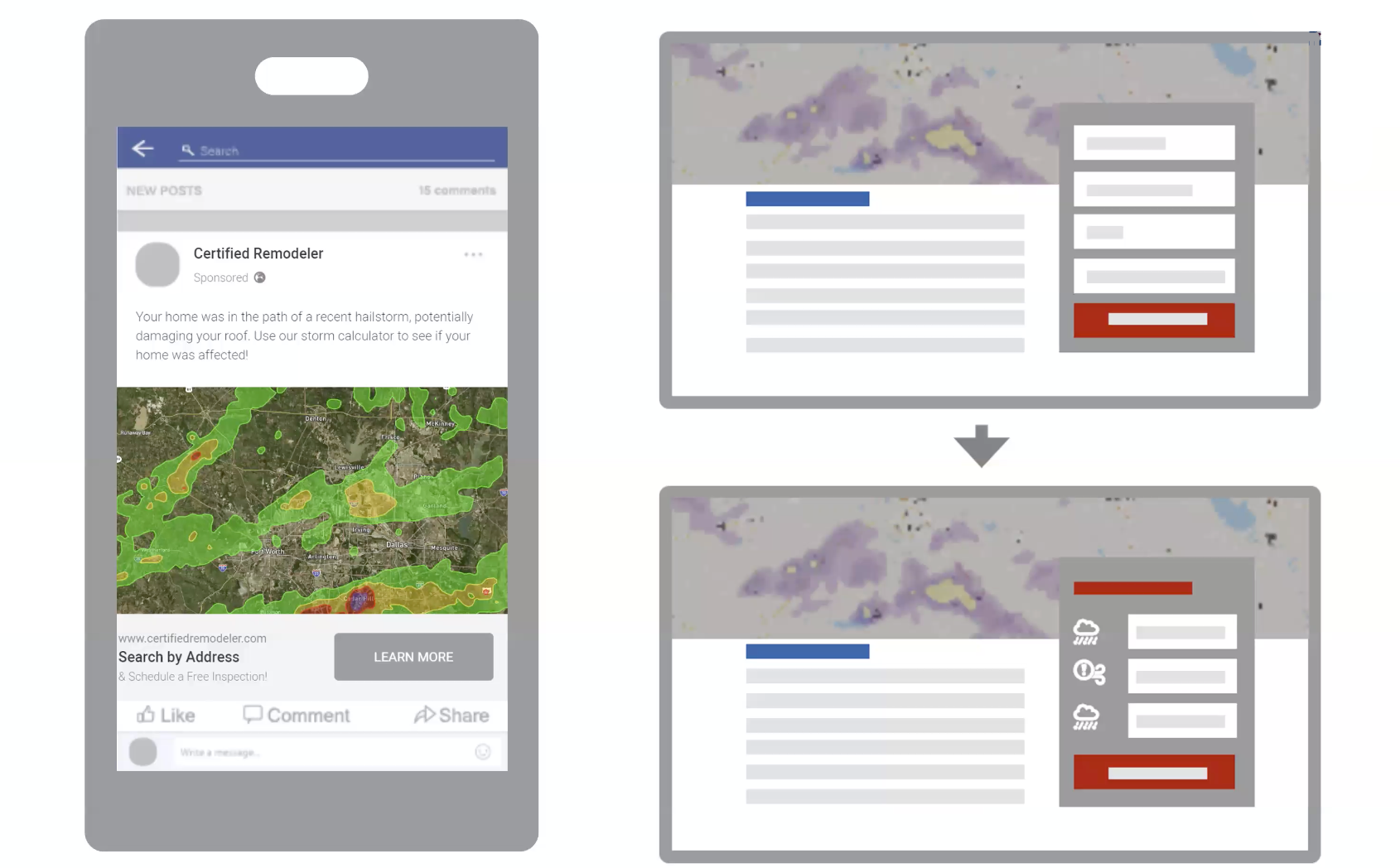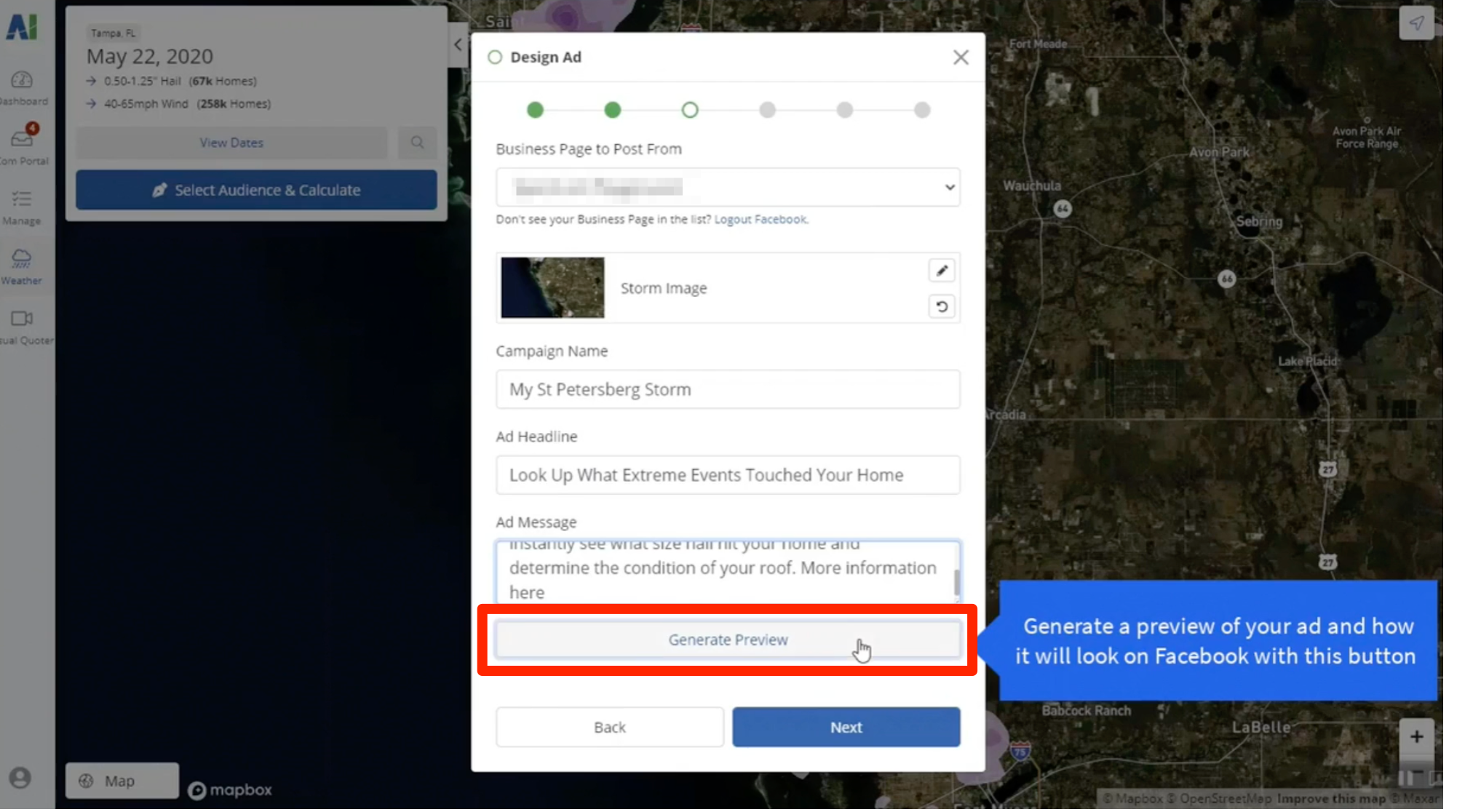In the process of launching your storm campaign, our tool will automatically create your Facebook ad and populate it with recommended imagery and copy. You can make minor tweaks to what we've provided for you, or you can totally revamp it with a new image and text. It's completely up to you.
If you do decide to customize your storm campaign’s Facebook ad, however, we recommend that you follow certain best practices to ensure you’re maximizing your lead capture potential.
Editing Your Storm Campaign Facebook Ad
After you've chosen your target area on the Weather map and set your Facebook ad campaign details, you'll be brought to an AI-generated Facebook ad similar to the one below. From this panel, you'll be able to make all of your preferred edits to imagery and copy.
You can see how your edits look in real time by clicking the Generate Preview button as shown above.
Keep in mind that our default copy is not random or generic; it has been crafted based on conversion copywriting best practices and real-world testing. You can change it if you want to, but you do not have to.
Tips for Choosing Your Facebook Ad Copy and Imagery
1. Show the Homeowner’s Local Area
For the most compelling ad, you want the homeowner to be able to see their local area in the image and to immediately recognize and place themselves there. It’s always more compelling to see a road or natural landmark that you can recognize.
Our tool will automatically upload an image of the area that you drew on the weather map when you began your campaign. You are free to change this image if you want to.
2. Keep Your Call-to-Action Soft
Social media users are bombarded with ads 24/7. To make your ad appealing, use terminology that sparks curiosity and genuine interest rather than anything that may come across as pushy, overdramatic, or pressure-filled.
It is always a good idea to be direct and use a strong action verb in your ad’s headline, but keep the tone educational and informative. The goal is to come across as a casual, “Hey, did you know?” or “Hey, have you heard?” rather than a salesy ad.
Here are some good verbs to try out in your headline:
- Find out
- Know
- Discover
- See
- View
- Learn
- Check out
- Look up
- Get insights
For even greater impact with your call-to-action, try incorporating some urgency-building words like “now” or “instantly” or “immediately.”
3. Use Local Terms as Relevant
Just like local imagery, personalized location words will also grab attention. In the ad’s description text, feel free to mention the region, city, or neighborhood that you’re targeting. If you’re hypertargeting an area, you could even throw in some local landmarks, major intersections, or common slang to make your company more relatable.
4. Incorporate Specific Dates
Specific dates also help grab attention. An announcement that “On March 25, 2020, Old Lake Highlands was hit by 2-inch hailstones” is much more captivating than “Dallas area homes are prone to hail.” For example:
- On July 14, 2020, your area was affected by a large hailstorm. Find out if your home was damaged.
- In March 2020, Church Falls experienced winds of 65 mph and up. Was your home affected?
- Your Springfield neighborhood received 1.25” hail in February 2019. Only 1 month left until your claim period expires!
5. Avoid Overly Definite Terminology
In your ad’s description text, it may be best to avoid phrases like “Your roof was hit” or “Your roof was damaged.” These sentences are very definite and may not be true. Even though our hail swaths are among the most accurate in the industry, none are 100% accurate for every single property. Also be careful with your wording if you mention insurance, in order to avoid promising anything definite.
6. Keep Character Limits in Mind
As you write your ad copy, keep Facebook’s recommended character limits in mind:
- Headline Text: 25 characters
- Body Text: 125 characters
- Link Description: 30 characters
Don't forget that you can always click the “Generate Preview” button to see exactly how your ad will appear on Facebook and to make sure that your text isn't being cut off.
7. Grab Attention with Emojis
Emojis say a lot with very few characters, and they're understandable and attention-grabbing for a wide audience. They can also help you come across as friendly and personable. For storm campaigns, emojis like these work particularly well: ⛈️ 🏠 ⚠️
Why Your Facebook Ad Creative Matters
In a PSAI storm campaign, your Facebook ad is just the first step to generating and converting leads for your business. The image below shows how your ad creative fits into the bigger picture.

- A great Facebook ad entices the homeowner to click, leading them to a branded landing page that we'll automatically create for you.
- A great landing page entices the homeowner to provide their contact information in exchange for a personalized storm report.
- A great storm report—accurate, detailed, and relevant—entices them to schedule an appointment with you. Even if they do not set up an appointment right away, you'll have their contact information saved to your Com Portal and can reach out for a soft follow-up.
Following the creative best practices described above will give you the strongest chance of catching your target audience’s attention and getting them to click through to the next step.
Disclaimer: Spectrum will not be held responsible for performance should you change our suggested ad copy for your storm campaign. If you have any questions about our creative choices or if your Facebook ad has been rejected, please submit a ticket for Support through this link or the Help widget in the bottom right-hand corner of your screen.

